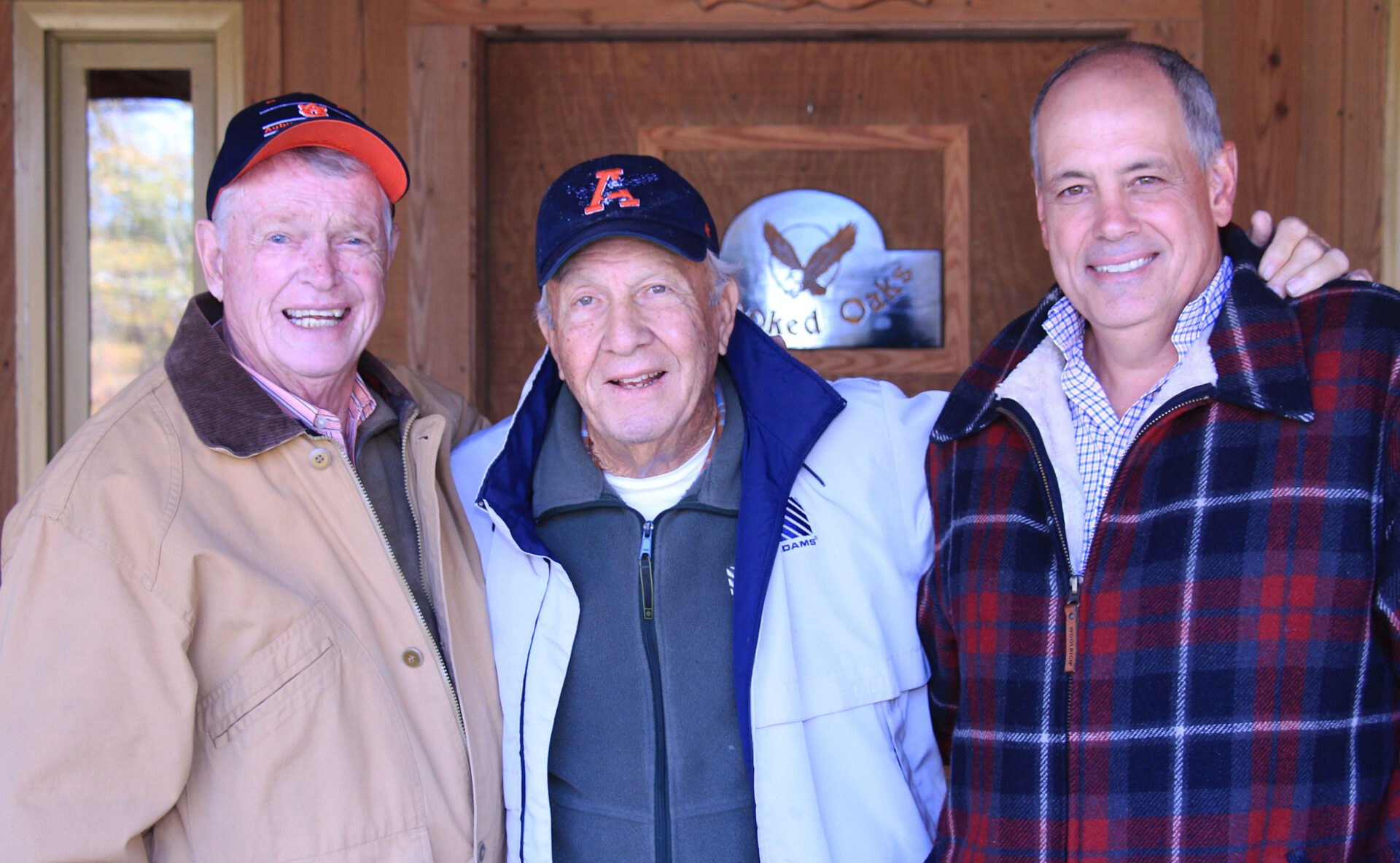Former Auburn coach Pat Dye is busy raising Japanese maples, hosting hunters at his lodge, and conducting his own radio show. In his spare time, he reads the works of Jane Austen (no kidding) and visits author Harper Lee. All that adds up to one heck of a life.
by AL BLANTON
Pat Dye likes to watch things grow.
For a few decades of his life, he liked to watch football players sprout from orchards of crude saplings to strong, winning oaks. And under his leadership, they always did. East Carolina. Wyoming. Auburn.
Now Dye, 75, likes to watch his assortment of Japanese maples grow, on his farm just west of Auburn in the little town of Notasulga, population 916.
Dye’s farm boasts a hunting preserve called “Crooked Oaks,” complete with a lodge, pond, horses, a guesthouse, the waterfall-happy Japanese maple farm known as Quail Hollow Gardens, and Dye’s actual house. The hunting lodge where Dye often hibernates is garnished with a series of wildlife paintings of alert setters pursuing their fowl (one is called “Hillside Flush”), heaps of VHS tapes, carved-log rocking chairs and endtables, and Native-American-themed sofas with leaping trout needlework on the pillows. A fire is twitching in a pit, and the large flatscreen TV cattycornered against two wood-grained walls is showing—what else—but the SEC Network.
Sporting a crinkled wool Auburn hat, the former coach growls about the team that he’s loved since they issued him his signing papers. He’s an Auburn man, through and through. He is Auburn.
Today, a large spread of lunch is prepared. Dye blesses the food. He assures later that his faith is private, but in this moment it is demonstrably public. After a gorgeous chili-and-sandwiches lunch, he hops in his old truck and rattles across his property, pointing out a spread more delicious to the eye than chili to the tongue. Horses swishing their tails, tree leaves trembling in the wind, cattails dancing, dogs nodding off in their straw beds. And—oye!—the Japanese maples.
“Every tree you see, I planted,” says Dye in his native Georgian dialect, scanning the property with his hand. “There are seven thousand trees in this Japanese maple garden. The thing I like about it, there are over two thousand varieties. You’ve got Red Upright, Green Upright, you’ve got Green Cascadin’, you’ve got dwarfs, you’ve got pygmies. They’re young, they’re old. I’ve got three right over here that are over sixty years old.”
While there are thousands of varieties of Japanese maples, there is only one variety of Dye. A Dye is a straightforward specimen, startlingly honest, hardworking, saltwater tough. Honestum Dyeum. And while the maple foliage bursts forth in many colors, only two colors matter to Dye: orange and blue.

Before leading Auburn to four SEC championships and flipping the script against archrival Alabama, Dye had to understand what it meant to be an Auburn man. Raised in Georgia, Dye played linebacker for the Bulldogs, went to chilly Canada to play for the Edmonton Eskimos of the CFL, and entered the service before returning to the South in 1965 to learn from the biggest growler of them all—Bear Bryant.
“I applied for it and Bryant offered it,” recalls Dye, speaking of the assistant coaching position at Alabama. “I had never walked on the field as a football coach, but he put me on the payroll that day.”
Dye’s main objective was to be the best linebackers coach he could be. And for nine seasons, he manipulated linebackers into outstanding specimens, planting toughness and fundamentals into their soil.
In 1973, Dye was ready to bloom into a head coaching role, and East Carolina plucked him away from ‘Bama. “It was a great six years at East Carolina,” says Dye. “I loved Greenville. The people. The community. The whole state was a menagerie. You had Duke, you had North Carolina, you had NC State…”
After six good seasons, a disagreement erupted with the ECU admins, and Dye bolted for Wyoming. “I thought if I could go over to Wyoming and win, then I could coach,” he says.
Dye took an abysmal program and made it a winner—as the Cowboys went 6-5 in his only season in the Rockies. “I loved the time I spent there,” Dye says. “But my heart was in the Southeastern Conference.”
Fortuitously for Dye, the Doug Barfield era of Auburn football was coming to an end, and he landed on the short list of candidates (others included Dan Reeves, Grant Taft, Jackie Sherrill, Bobby Bowden, and Dick Sheridan) to replace the embattled coach.
Dye assures that several on the board “liked him” and that others, such as ECU’s Reynolds May, gave great referrals. So Auburn went out on a limb and hired their new Plainsman—by way of Wyoming, North Carolina, Tuscaloosa, Canada, and Georgia.
“I didn’t know anything about Auburn,” Dye assures. “But I learned as much as I could, as fast as I could. I spoke to hundreds of clubs, and I also learned a lot from one-on-one conversations on a plane or if someone was giving me a ride. The more I found out, the more I knew this is where I needed to be. I read “The Auburn Creed” by George Petrie and I thought ‘that’s me.’ It’s been a love affair ever since.”
But like all love affairs, the Dye-Auburn romance wasn’t devoid of its share of tumult. Dye is forthright about his last year as Auburn’s head coach, scarred by the Eric Ramsey saga, which signaled the end of the Pat Dye era of Auburn football. That same entity that hired him also held the power to push him out, so Dye realized. “I resigned because I lost support from the Board. The Board didn’t want to fire me, either, but somebody had to take the bullet.”
In many ways, Dye’s tale is one of sadness, an anticlimactic end to a terrific run by a terrific ball coach. Dye maintains that he resigned principally because he knew there could be life after football, after coaching. Since then, he’s made an awfully good twenty-two-year run in his second life.
Dye’s regeneration was accomplished in large part by going back to his roots and developing something to which he’s always had a certain kinship: the earth. “I’ve developed five or six different pieces of property,” says Dye. “I buy them, fix ‘em up, and sell them.” One such property near Shorter, Alabama, Dye calls the “prettiest place in Alabama.” Crooked Oaks ain’t too bad either.

While he’s not hunting, fishing, doing radio, growing his garden, or running dogs, Dye likes to read and watch movies. “I like To Kill a Mockingbird,” says Dye. “Harper Lee is a hero to me. She remembered those tragic days of the thirties and had the wisdom, courage, and guts to put it on paper. I go over and see [Harper Lee] from time to time in Monroeville.”
A newspaper article that described Lee’s fascination with English author Jane Austen led to Dye gobbling up several of Austen’s books. “I saw that and thought, ‘Who the hell is Jane Austen?’” Dye says. “So I read Pride and Prejudice. I read Emma. I read Sense and Sensibility.”
The conversation somehow turns to movies, and Dye has just watched August:Osage County, starring Meryl (pronounced “Merle”) Streep. So what else does he like?
“Secretariat. I like that one.”
(NOTE: This is the moment you don’t suggest that Secretariat is a Disney movie, unless you want Dye to respond with a noun that is synonymous with Angus patties.)
Besides British novels and watching a little pigskin on the set, a good day to Dye involves getting up at 5 a.m.—“you ought to get up around 5 a.m.,” he says—tending to the garden and the horses, feeding the dogs, and getting ready for his nighttime radio broadcast, “The Pat Dye Show.”
As Dye sits in his chair in his rural home and reviews his life, his face is shadowed. He talks about Bo Jackson (“very, very intelligent,” he says), Frank Thomas (the second best athlete he’s ever coached), and Nancy. “The love and daily care of the animals, the landscaping, the care, the thought that went into the planning and attention to detail—at least fifty percent of the credit goes to Nancy,” Dye says. “She’s my partner in the farm, my partner in life and my soulmate.”
But mostly, he talks about football, and how he helped to change the mentality at Auburn.
“I had a feeling when I got here that all people wanted to talk about was Alabama,” Dye says. “I didn’t want to hear that. And I felt that many of the Auburn people were intimidated by Alabama. Being intimidated, that is a terrible thing.”
So Dye did what he knew best. “We just went to work,” he says. “I’m not sure if I overworked them. The coaches. The players. But we wanted to find out two things: Do you like football? Do you like Auburn? If they loved both, we had it made.”
And what is Auburn?
“The Auburn Creed” begins with the following statement:
I believe that this is a practical world and that I can count only on what I earn. Therefore, I believe in work, hard work.
“Auburn ain’t for everybody,” Dye says. “The bright lights, the fancy stuff, being able to impress people. Auburn ain’t that kind of place.”
A good day to Dye is being in Auburn, being a part of the Auburn family every day of his life.
“I want you to know that Auburn is my home,” says Dye. “It’s where I’m going to live. I’m going to be here forever.” Talegate
This article was originally published in 78 Magazine in 2015.








